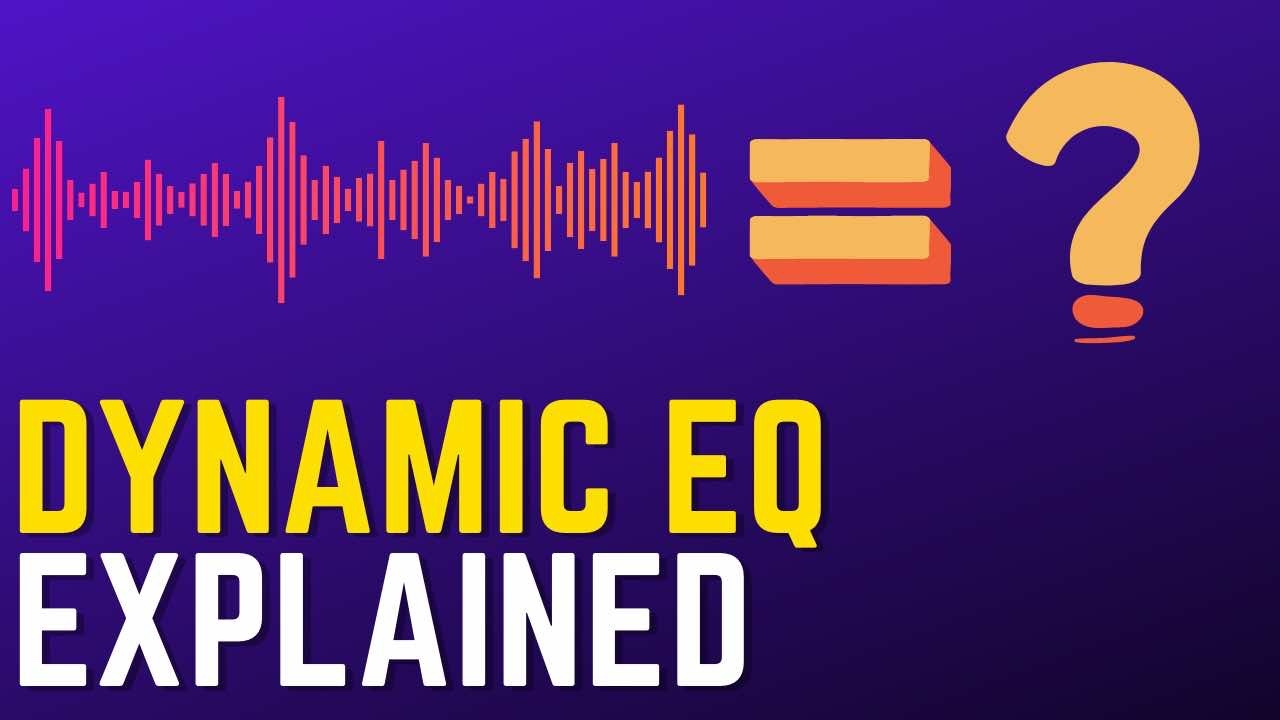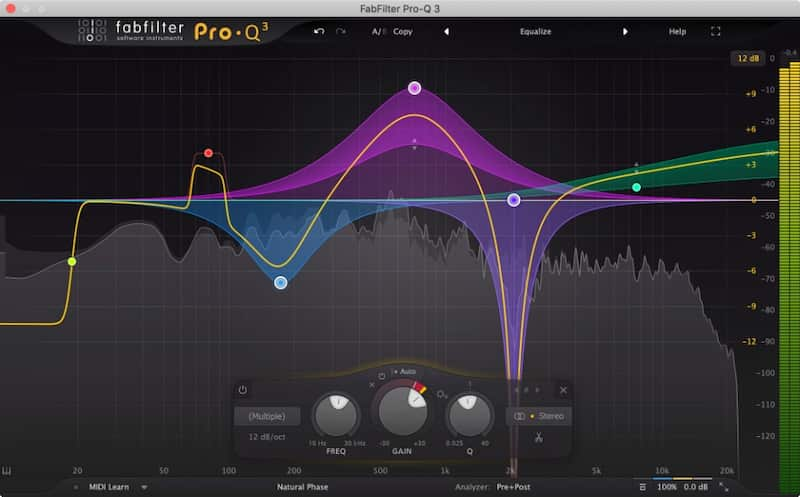How To Mix With Dynamic EQ

Everyone knows how crucial EQ is for mixing. When you pair EQ with compression, you can seamlessly blend tracks together so that they play nice and create a single, cohesive unit.
However, sometimes the static nature of EQ doesn’t work, especially when you consider how elements of a song can evolve from start to finish. Nowadays, we have dynamic EQ, which provides all of the classic characteristics of EQ with a new dynamic twist.
Today, we’re going to dive in and give you the lowdown on dynamic EQ!
Note: this article may contain affiliate links, which mean that I receive a commission for any purchases you make, at no added cost to you.
What Is Dynamic EQ?
Dynamic EQ is a unique modern mixing tool that blends traditional equalization elements with dynamic control parameters typically found in compressors. The way that dynamic EQ works is very similar to traditional EQ. However, instead of having a fixed gain value for each of your EQ bands, you can use the dynamics of your EQ’d signal to determine how much you cut or boost.
While it might sound overwhelmingly complex for some people, it’s actually quite simple. Basically, you can think of a dynamic EQ as a processor that adjusts how much EQ is applied based on the incoming signal.
What Does Dynamic EQ Do?
Like I said earlier, traditional EQ works with a fixed gan value. However, with a dynamic EQ plugin, the gain of your chosen EQ band will change depending on the intensity of the incoming signal.
The income-signal-dependent processing is the same as a compressor or expander.
Essentially, you can set a threshold for each EQ band like you would with a compressor. When your input signal goes above that threshold, the dynamic portion of your EQ will begin working.
If you want it to attenuate the signal that goes above the threshold, you can set your dynamic EQ to compress. On the other hand, if you want your dynamic EQ to boost the signal that goes above the threshold, you can set it to expand.
When To Use Dynamic EQ?
Whenever you’re in need of slightly more control over the frequency balance of your signal, dynamic EQ can be helpful. Of course, you could spend tons of time automating your traditional EQ plugins to get the same results, though this could take up plenty of valuable time.
Dynamic EQ is great for attenuating (cutting) distracting frequencies that stick out of the mix during certain parts of the performance. This is often true for highly dynamic sources, such as acoustic guitar or vocals.
For example, you might get a weird resonance that pops out in a singer’s voice during a specific phrase. While you could use multi-band compression to tame it, you’ll only be reducing the level of the vocal during that specific part, not getting rid of the nasty frequency.
Trying to simply EQ the vocal won’t work either, especially if the vocal sounds great throughout the rest of the track. If you need to cut 550Hz to get rid of a nasty resonance during a single part, though you choose to use regular EQ to notch our 550Hz, then you’re getting rid of that frequency in other parts of the song where it might be necessary.
How To Use Dynamic EQ
Let’s look at a few common ways you might choose to use dynamic EQ.
How to Use Dynamic EQ to Get Rid Of Shrillness In a Singer’s Voice
We’ve all been there before. We’re mixing vocals, and everything sounds great. However, when the singer gets to a certain note with a certain vowel, we get a nasty shrillness that takes us out of the whole song.
With dynamic EQ, we can set it in such a way that it reduces that shrill frequency whenever it gets too loud. Whenever that shrill frequency isn’t there, the EQ will sit neutral.
Just find the shrill frequencies (usually in the upper mids) and set them to cut by 3-6dB whenever the singer really belts.

How to Use Dynamic EQ to Tame High-Frequency Cymbal Harshness
The cymbals might sound heavenly throughout the entire piece. However, when the band gets to the last chorus, the drummer starts bashing away, creating a harsh smattering of high frequencies that hurt to listen to.
With dynamic EQ, you can tame that high-frequency harshness during that part while leaving it untouched during the rest of the song.
I like to use a dynamic high shelf for this. I usually start with the frequency set around 10kHz, with a 3dB gain reduction. This is usually enough to keep the volume manageable without robbing the energy from the overheads.
How to Use Dynamic EQ to Carve Out Space For Vocals
One of my absolute favorite ways to use dynamic EQ is carving out space in the mix for vocals if your dynamic EQ has a sidechain feature. This is one of the Pro-Q3's killer features.
Place your dynamic EQ on an instrument that is masking your vocals (ex., Stereo electric guitars in a heavy rock song or bright sawtooth synth in an EDM track), then sidechain it so the EQ bands only react when the vocals appear. Set one of the frequency bands from about 1-3kHz (or wherever your vocal is most present).
Whenever the vocals appear, the competing instruments will duck down at that particular frequency, though whenever the vocal isn’t there, the instruments will remain completely intact. It’s a great way to have your cake and eat it too, especially when you’re dealing with busy mixes.
Best Dynamic EQ Plugins
I've put together my top list of the best dynamic EQ plugins, for all budgets. If you can afford it, FabFilter's Pro-Q3 is the number one EQ I'd recommend. If things are a little tight, though, check out Waves' F6.
And if you're looking for the best free dynamic EQ, be sure to checkout TDR Nova!
Best Dynamic EQ Plugin - FabFilter Pro-Q3
FabFilter has reimagined what’s possible with several traditional mixing tools, and the Q3 plugin isn’t an exception. While the developers don’t market it as a dynamic EQ, it has dynamic EQ possibilities that you can enable with this plugin.
Taking it a step further, they also have a spectrum analyzer that sits behind the EQ curve, allowing you to get a better idea about the frequency spread of your signal.
You can read the full review of the Pro-Q3 EQ here, but it would probably be one of my top recommended plugins of all time. It's powerful, easy to use, and kind to your CPU.
Best Waves Dynamic EQ - F6
The F6 Dynamic EQ from Waves offered six fully adjustable parametric EQ bands, as well as a high-pass and low-pass filter. This highly functional EQ plugin is great for complete control, offering free-floating bands, variable EQ shapes, and a handy sidechain mode.
The F6 also has a built-in frequency spectrum analyzer with adjustable reaction speed and resolution.
Best Free Dynamic EQ - TDR Nova Dynamic EQ
If you’re on a serious budget, TDR Nova gives you access to all of the wonders of dynamic EQ for free. With fully parametric capabilities and an intuitive interface, it stands up to many paid plugins in the same realm. You even get a handy spectrum analyzer, which we wouldn’t expect from a completely free plugin!
Dynamic EQ FAQ
Here are some of the most common questions I've received about using dynamic EQ.
Dynamic EQ vs. Multi-band Compression
While dynamic EQ might sound a lot like multi-band compression, there are some key differences to note:
- Multi-band compressors often use steep crossover filters to differentiate the frequency regions for processing.
- Dynamic EQ allows you to use EQ filter shapes for processing, such as bells or shelves.
In my eyes, dynamic EQ is better for precise frequency corrections, such as a vocalist that gets too nasally during a certain passage, though sounds great for the rest of the song.
Dynamic EQ vs. De-Esser
De-essers are much like multi-band compressors, though they have unique algorithms that detect sibilance and other high-frequency sounds. While you could certainly perform the same task with a dynamic EQ, the lack of crossover filters to reduce volume in a dynamic EQ is what makes it a different type of processor.
A dynamic EQ makes use of an independent bell-shaped filter to achieve the effect. Plus, dynamic EQs aren’t designed to be used for a specific frequency range like de-essers are.
How to use EQ Guides
To help you get the most out of your EQ plugins, we've put together these detailed guides to teach you how to use EQ on some of the most popular instruments.
- How to Mix with EQ
- Tips for EQing piano
- Electric guitar EQ tips
- How to EQ acoustic guitar
- How to EQ bass guitar
- How to EQ drums
- How to EQ vocals
- How to EQ woodwinds
- How to EQ strings
- How to Use Mid-Side EQ
- 3 Powerful Ways to Use Dynamic EQ
- How to EQ Loops
- How to EQ Reverb
- How to EQ Percussion
From a Frustrated Producer in a Ragtag Bedroom Studio to Major Placements on TV Earning $1,000s!
My name is Evan, and I've been making music since around 3rd grade. I'm from San Diego, California, but I've lived in Washington, DC for the last 20 years.
While I still have a full-time day job, I have created systems that have allowed me to produce dozens of songs a year in my spare time.
My songs have been on Netflix, TV shows like the 90 Day Fiance, an award-winning indie film, and NPR’s “All Thing Considered.” They've also been streamed millions of times.
In addition to being a music producer, I am passionate about teaching people how they can make professional-sounding music and earn money licensing it, all in their spare time.
Thousands of musicians, like yourself, have trusted me to guide their musical journey. My YouTube videos have been watched nearly a million times. And my story has been in Forbes, Side Hustle Nation, and the Side Hustle School.







